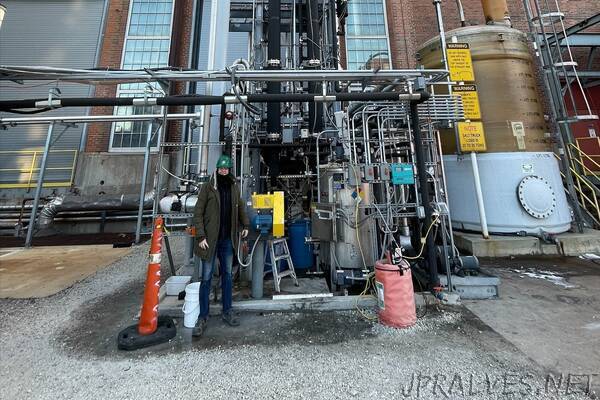
“Illinois Sustainable Technology Center (ISTC) researchers have given the thumbs up to an innovative biphasic solvent system for its efficiency and effectiveness in absorbing CO₂ from flue gas in a coal-fired power plant at the University of Illinois (U of I).
With $3.4 million from the U.S. Department of Energy (DOE) National Energy Technology Laboratory, an ISTC team sought to validate the various advantages of a biphasic CO₂ absorption process (BiCAP) at a 40-kilowatt electric small pilot scale at the Abbott Power Plant on the U of I campus. The system was designed based on the testing results at the laboratory scale under a previous DOE cooperative agreement.
Previous laboratory testing has proved the biphasic solvent-based process concept and has shown that the technique can achieve greater than 90 percent capture efficiency and greater than 95 percent CO₂ purity and has the potential to significantly increase energy efficiency and reduce CO₂ capture cost.
From the recent field testing, the team verified that their technology could achieve 95 percent efficiency in CO₂ capture, compared with 90 percent in conventional methods, with a 40 percent higher energy efficiency. The cost advantages have not yet been determined, but previous laboratory testing showed a 26 percent cost reduction. The system has also been shown to run continuously for two weeks, verifying that it can operate under Midwest winter weather conditions.
“The conventional CO₂ capture process has several disadvantages, and our goal was to reduce the carbon footprint and costs and increase the energy efficiency,” said Yongqi Lu, principal investigator. “These energy-efficiency advantages of the BiCAP system, coupled with reduced equipment sizes when scaled up for commercial systems, will lead to reductions in both capital and operating expenses.”
The BiCAP method uses biphasic solvent blends that can form and develop dual-liquid phases during CO₂ absorption. The solvents, which were tested and selected in previous DOE-funded studies, are highly resistant to degrading from either high temperatures or oxidative atmospheres. Also, less solvent is required for this process.
Although the focus of the study was on CO₂ capture from flue gas at coal-fired power plants, the BiCAP technology can be used in natural gas combined cycle (NGCC) plants as well, incorporating flue gas from natural gas, biomass, plastics, and other renewable materials.
“The exciting feature of this capture technology is its robust nature and ability to be used on a variety of flue gas sources. We are now ready for commercial partners to assist in moving this technology to the marketplace,” said Kevin OBrien, co-principal investigator for the project and director of ISTC.
Preliminary tests with synthetic NGCC flue gas made of air and bottled CO2 gas have been performed on the small pilot unit recently. Results revealed that a 95 percent CO2 removal rate could be achieved, and the energy use only slightly increased compared with that for the coal flue gas that contains more concentrated CO2.
The concept of biphasic solvents was developed as part of a dissertation research project in 2013–2015. From 2015 through 2018, screening of biphasic solvents and studies of proof of the BiCAP process concept were conducted at the laboratory scale with funding from DOE. After that, the small pilot system was designed, constructed, and tested at the Abbott Power Plant with continued DOE support.
The main research team for this project was transferred from the Illinois State Geological Survey (ISGS) to ISTC in January 2022. Now that the team has collected the data, the next steps are to complete a techno-economic analysis, then scale-up the technology for commercial use.”
